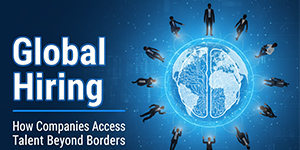Employee Benefits & Bonus Trends: 2025 Industry Insights
When the year 2025 arrives, businesses are rethinking the ways in which they recruit, keep, and inspire their employees. They demand real employee benefits, perks, and incentives that support their financial stability, work-life balance, and personal growth. The modern workforce wants more than just competitive salaries; they want compensation that is in line with their expectations. The landscape of employee benefits trends and workplace bonus trends is fast altering, with features like as performance-linked bonuses and flexible working arrangements among the most prominent examples.
In the following, we will discuss the top employee benefits and bonus trends for the year 2025, as well as the ways in which firms are transforming their corporate benefits packages and what employees can anticipate across any given industry.
 |
The Rise of Holistic Employee Well-Being ProgramsThe concept of holistic well-being is expected to be one of the most significant developments in employee benefits trends in the year 2025. In addition to the typical health insurance, businesses have begun to incorporate wellness programs that focus on physical, emotional, and financial wellbeing. |
As part of their employee perks and benefits, employers are now providing mental health applications, meditation subscriptions, and even treatment stipends to their employee perks and benefits.
The industry compensation trends suggest that activities aimed at improving employees' well-being are closely linked to increased productivity and employee retention. A decrease in employee turnover and an increase in employee engagement are two benefits that businesses who invest in complete wellness benefits are experiencing.
Additionally, the expenditures for corporate wellness have increased by thirty percent in comparison to the year 2023, which indicates that the corporate benefits 2025 will continue to place an emphasis on the happiness and balance of employees rather than merely monetary rewards.
Personalization and Flexibility Define the New Normal
The world of employee incentives and rewards has reached a point where flexibility is no longer a negotiable need. The employee benefits trends are currently dominated by the availability of remote work options, hybrid schedules, and tailored rewards. The emergence of personalized benefit packages can be attributed to the fact that businesses are aware that the factors that inspire one employee might not be effective for another.
When it comes to the best corporate benefits packages by industry, employees are given the opportunity to select from a variety of advantages, including assistance with child care, stipends for working from home, pet insurance, and additional paid time off. This change demonstrates how organizations are modifying their benefits and incentives in order to cater to the varied requirements of their workforce.
Particularly prevalent in the fields of technology and finance are flexible stock options, and school subsidies. On the other hand, the healthcare and manufacturing industries place a greater emphasis on wellness and safety-related incentives.
Performance-Based Rewards Are Evolving
Organizations are modernizing the ways in which they measure, and reward success in the workplace, which is a trend known as workplace bonus trends. Incentives schemes that are based on quarterly or even real-time performance are gradually replacing the traditional annual bonuses. By utilizing data analytics, and performance tracking systems, businesses are now able to provide employee incentives and rewards on a more regular basis, thereby matching recognition with achievement in a manner that is nearly instantaneous.
These flexible bonus schemes have emerged as a fundamental component of increasing trends in employee bonuses across different sectors. organizations in the creative professions, for instance, are paying recognition awards for creativity or teamwork, while organizations in the sales, and technology industries are implementing project-based employee bonuses.
This strategy guarantees that awards continue to be visible, timely, and directly related to measurable accomplishments which is a crucial factor in maintaining employee engagement in a work environment that is fast-paced.
Emphasis on Learning, Growth, and Career Development
The new generation of workers places equal importance on possibilities for professional development and monetary compensation. As a consequence of this, the employee perks and benefits in the year 2025 typically consist of access to online courses, mentorship programs and professional instruction.
There is a twenty percent increase in employee retention rates for businesses that make investments in continuous learning, as indicated by the most recent industry compensation trends. As a competitive difference in salary and benefits comparison surveys across industries, these educational incentives are also becoming increasingly important.
Personal development is increasingly a significant component of total compensation as evidenced by the fact that leading companies are incorporating learning leave policies and professional development stipends into their corporate benefits 2025 strategy.
Equity, Inclusion, and Fair Pay Are Central to Corporate Strategy
These days, fairness and openness, are fundamental foundations of the developments that are occurring in employee benefits trends. The publication of wage ranges and the establishment of uniform frameworks for bonuses and promotions are becoming increasingly common across businesses.
It is no longer the case that diversity and inclusion are confined to the hiring practices; rather, they are now ingrained in the manner in which employee incentives and rewards, are allocated. Salary and benefits comparisons are carried out on a regular basis by many companies in order to guarantee pay parity across gender, ethnicity and region.
A culture of trust and belonging, is fostered through the implementation of corporate benefits programs in the year 2025. These programs, are designed to eradicate hidden inequities, and to make every employee feel appreciated.
Sustainability and Social Impact Incentives
One more fascinating development in the manner in how companies are changing perks and incentives is the introduction of awards that are centered on sustainability. Providing employees with benefits that are related to social effect is a response from corporations to the fact that employees are motivated by purpose.
Currently, there are certain companies that provide their employees with paid volunteer days, bonuses for carbon offsets, or donations to charitable causes that they have chosen. Particularly appealing to younger generations who place a high value on environmental responsibility are the employee perks and benefits that are offered to employees who are environmentally sensitive.
Programmes that are driven by sustainability are helping businesses improve their employer brand while also making a beneficial contribution to society. These programmes are among the top employee benefits and bonus trends.
Technology-Driven Benefits Management
The administration of corporate benefits in 2025, is being reshaped as a result of technological advancements. Using technology, businesses, are simplifying employee incentives and rewards in a variety of ways, including blockchain-secured payroll systems, and HR portals powered by artificial intelligence.
Now, with just a few clicks, employees can access real-time dashboards that salary and benefits comparison, monitor bonuses that are dependent on their performance and personalize their benefits themselves.
Transparency that is facilitated by technology has emerged as an essential component of the overall industry compensation trends. This transparency enables both employers and employees to have a better understanding of the value of their whole incentives package.
Expanding Family and Lifestyle Benefits
Benefits that are accommodating to families, have emerged as a fundamental component of employee benefits trends in the year 2025. Additionally, employers are upgrading their parental leave policies, providing assistance with fertility and adoption and even providing assistance with eldercare concerns.
Furthermore, the workplace bonus trends indicate that organizations are expanding the types of incentives they provide to their employees beyond monetary compensation. These incentives include sabbaticals, travel stipends, and wellness retreats.
This broader view of remuneration represents a more empathic approach to the needs of employees, and it aligns with the best corporate benefits packages by industry, which are characterized by human-centered policies that encourage happiness and loyalty.
Benchmarking Across Sectors: Who’s Leading the Way
An examination of the differences in salary and benefits comparison across different sectors finds some fascinating trends. Financial incentives are most prevalent in the technology and finance industries, whereas the healthcare industry places an emphasis on safety and well-being, and retail and hospitality places an emphasis on flexibility and recognition programs.
The performance-based models are the most frequent in fast-growth industries, whereas loyalty bonuses and retention incentives are more common in industries with high turnover. This is the conclusion that can be drawn from an analysis of patterns in trends in employee bonuses across different sectors.
In the end, the best corporate benefits packages by industry blend old perks with current priorities, striking a balance between competitive pay, relevant rewards, and employee well-being.
Globalization and Remote Work Benefits
An upsurge in the number of corporate benefits 2025 programs has been driven by the proliferation of worldwide teams. Now more than ever, businesses need to devise perks that are appealing to employees operating in a variety of countries and cultures.
The use of data-driven salary and benefits comparison models, as well as reward structures that are specific to regions is being implemented by businesses in order to guarantee fairness.
Financial Wellness and Future Security
As a result of the growing economic unpredictability, the concept of financial wellness has become an essential component of the employee benefits trends.
As part of their employee perks and benefits, businesses are expanding their offerings to include retirement planning sessions, savings programs, and even assistance with the repayment of college loans. Financial incentives like these help employees feel less stressed and improve their trust in one another.
Financial literacy programs are among the benefits that are expected to expand at the quickest rate in 2025, according to the most industry compensation trends. These programs give employees the ability to make better decisions regarding their long-term financial situation.
Considering the current trend of globalization, it is more important than ever to have employee incentives and rewards that are not only flexible and inclusive, but also adapt to local expectations while still preserving worldwide consistency.
Recognition, Culture, and Human Connection
In addition to monetary compensation, employees yearn for praise. By the year 2025, there will be a significant increase in the prevalence of workplace bonus trends and peer-to-peer recognition systems in the workplace.
Apps for social recognition, initiatives that recognize employees of the month, and funds for team celebrations are all examples of ways that firms are incorporating thankfulness into the routines of their employees.
For the purpose of ensuring that employees feel recognized, valued, and connected, this cultural evolution is changing the employee incentives and reward that are offered to employees.
The Future of Work and Total Rewards
As we look to the future, we can anticipate that employee benefits trends, will continue to evolve with demands in the workplace. It will be necessary for businesses to find a middle ground between the use of technology, personalization and human interconnection.
The concept of continuous recognition and adaptive reward systems that reflect each employee's contribution in real time is where the future of workplace bonus trends rests. On the other hand, the employee perk and benefits will be expanded to include components related to lifestyle, education, and sustainability.
Organizations who are able to keep ahead of the changes in the industry compensation trends and consistently reinvent their corporate benefits programs, will be able to attract top people and maintain long-term success beyond the year 2025.
Conclusion
The age in which income was considered the primary reward is beginning to fade away in the year 2025. On the contrary, the trends in employee benefits and workplace bonuses are the ones that are driving the race for talent. Reimagining employee perks and benefit, calibrating employee incentives and reward and aligning their plans with industry compensation trend are all practises that the most successful companies are integrating into their operations.
A variety of strategies are being implemented by businesses in order to attract and retain employees. These strategies include individualized benefit packages, investments in mental health, spot bonuses, team incentives and equity stakes. In order to maintain one's relevance, it is essential to monitor and compare salaries and benefits, to benchmark information across different industries and to test out new models.
The same principles apply regardless of whether one works in the field of technology, healthcare, manufacturing, finance, retail, or nonprofit organizations: flexibility, fairness, meaningful rewards and the successful incorporation of benefits into the employee life cycle. Companies need to maintain their flexibility in order to keep up with the most recent trends in employee benefits and bonuses. This includes listening to the priorities of employees, iterating their programs and making certain that perks and bonuses, are not only appealing but also linked with the company's strategy and culture.





